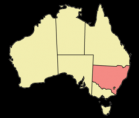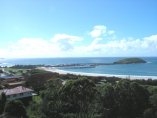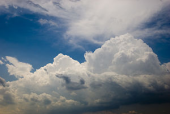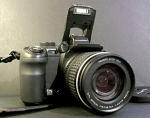introduction

Snowdog: Map of Australia highlighting New South Wales; 30 December 2005
New South Wales is one of the states in Australia, that is located on the south-eastern coast of the country between Victoria and Queensland. The total area of the state is 809,444 km². The largest city and capital is Sydney.
Known in Australia as the Premier State, the Colony of Ne South Wales was formed in the late 1700's and at one stage incorporated the majority of Australia and New Zealand. Make sure you remind as many New Zeakanders as possible that they were once art of New South Wales - they love that kind of stuff.
surfing

Graeme Cameron: Coffs Harbour, Northern NSW; 2005
The points, reefs and beach breaks offer a wealth of potential for the surfer. The general north east lie of the NSW coasline ensures that there is always a spot neaeby that will receive excellent exposure to the predominant south to south easterly swell patterns that routinely bomb the coast in winter.
NSW has the largest population of any state in Australia so just be sure not to spend all of your time surfing around the city breaks, there is a wealth of less ridden talent out there.
weather

Lipton sale: Stormclouds, 16 November 2007
Temperatures in the mid to high 20’s (degrees Celsius) are common along the NSW coast in summer. Higher temperatures do occur at times, although a regular NE sea breeze tends to prevent things getting too hot for the most part. Temperatures dip into the mid teens in the far south of the state during the winter months, while in the far north of the state, temperatures remain closer to 20 degrees Celsius.
Water temperature ranges from as low as 14-15 degrees in the far south during winter, while the north sees temperatures remain at around 18 degrees. Summer time generally sees temperatures ranging from 21 in the south to 25 in the north. That being said, there can be large drops in water temperature during the summer months, especially along the southern half of the coastline. Sustained periods of winds from the NE can create an upwelling event, with warmer surface water moving away from the coast, allowing colder water to move in from off the continental shelf. This can drop the water temperature in Sydney down to a chilly 16 degrees, even in the peak of summer. The lesson here is to always have some wetsuit protection on hand. This can also be wise given the regularity of blue bottles (Portuguese man of war) in the water during the summer months.
Summer (Dec-Feb)
Summer can be plagued by extended periods of small swell, especially along the southern half of the coast. The northern half of the coast tends to do a little better swell wise, thanks to persistent SE trade winds between New Zealand and Fiji. The NE sea breeze is a common feature in summer, which is detrimental to surf quality at most locations. It can however produce sneaky NE windswells along the southern half of the NSW coast. There can be the occasional large cyclone swell along the northern half of the coast in summer and these are sometimes of benefit to Sydney and areas to the south.
Autumn (Mar-May)-Winter (Jun-Aug)
Autumn and winter is where the NSW coast comes into its’ own. Large southerly groundswells march up the coast from deepening low pressure systems that track from under Tasmania towards New Zealand, while the predominant wind direction is offshore W’ly as the sub-tropical high pressure system moves northwards.
Some of the largest and best swells can be produced by deep low pressure systems that regularly form of the NSW coast in the autumn and winter months. Cold airmasses tracking across the Australian Continent can interact with the warm sea surface of the Tasman Sea (between NSW and New Zealand), leading to the rapid formation of deep low pressure systems. These are often referred to as East Coast Lows (ECL). June has the greatest frequency of such systems, so if you are planning a surf trip to this state, this could be your best bet.
Spring (Sep-Nov)
Spring doesn’t really stand out for surf, although strong S’ly swells and lows off the coast can still occur. It is however usually a wind down period into summer. Sea breezes also become more pronounced at this time of year.
travel

Dhum Dhum: Driving hazards - a semi trailer and a road victim; 16 August 2003
There are two common ways of travelling in Australia: by car or by plane. Train can be an option, but not all states have a public rail network. Greyhound Australia provides a nation-wide (except Tasmania) interstate bus service. And there is a car ferry that departs from Melbourne and goes to Devonport in Tasmania.
The country is huge, so if don’t have enough time, take a plane. Fares are generally low, due to the amount of competition, and flights depart regularly. Main business travel corridor is Melbourne-Sydney-Brisbane with flights leaving every 15 minutes. You’ll be able to get to every state with Qantas, Jetstar, Virgin Blue or Regional Express. There also are some small state-based airlines that serve regional areas: Airnorth, Skywest, O’Connor Airlines and MacAir Airlines.
Travelling by car is a great option as well, especially to those who want to see and feel the country from he inside. Australia has a well-maintained system of roads and highways and drives 'on the left'. Keep in mind that great distances separate its cities and after leaving one of them, you can sometimes expect to travel for hours before finding the next trace of civilisation. So it’s a good idea to hire a satellite phone in case of emergency. The shortest distance would be from Sydney to Canberra – just 3-3.5 hours (~300 km). But it is a truly magnificent experience to hire a car and travel around the coast of Australia (check the Great Ocean Road), which you won’t forget.
where to stay

Erwin1990: Flag of Hotel Formule 1; 7 July 2004
Your final decision really depends on your preferences and budget. If you like camping, there are a lot of those in every state of Australia. And there is a great option for those, who still prefers some comfort, but the budget is limited, – Hotel Formule1. These hotels have absolutely the same basic and very clean rooms (for 3 people) in all the cities (so you know what to expect) and can be found in Sydney (NSW), Coffs Harbour (NSW), Melbourne (VIC), Canberra (ACT) and Brisbane (QLD). Rates can start from AU$59.00 per room/per night and conditions are usually better than in the numerous motels along the highways (where you will probably spend about AU$100 per room/per night).
There are nice caravan parks (van/trailer parks) with on site cabins in WA, as well as in most states (usually you will see the signs if you drive on the highway). Prices range from AUS$25.00 to AUS$50.00. They are very comfortable and have cooking facilities and a refrigerator. The extra price will provide you with some more comfort.
Cable Beach Backpackers is another nice place in WA with clean and spacious rooms, bathrooms and kitchens, just a few minutes walk from Cable Beach in Broome. Also try Augusta YHA – a very affordable and clean hostel in a brand new building.
And of course, there are all the luxurious hotels, where you can enjoy the best service. But basically for all the states the rule would be the same – there are numerous motels, hostels, caravan parks and camping sites near the surf spots, so you’ll definitely find something.
what to pack

Mohylek-Fujifilm Finepix S9000; 1 April 2007
Everything can be bought in NSW. So pack light and take only important things, such as sunglasses, hat and a good sunscreen. You will be comfortable in flip-flops, but also take a pair of comfortable walking shoes. A small backpack makes a good carryon bag and will be useful in daily life.
Loose casual clothing will be perfect for the hot/warm weather. Just in case of the rain, take some waterproof stuff and some warm clothes.
You can also take your surf geat with you, but no worries if for some reason you are not able to - there are numerous surf shops around the state.
Definitely don't forget your camera and have a plenty of memory/films.






